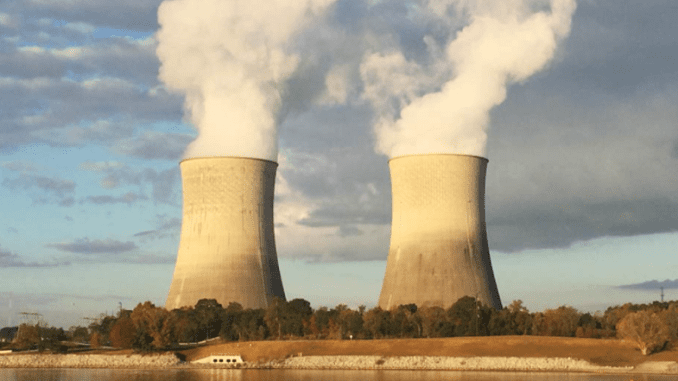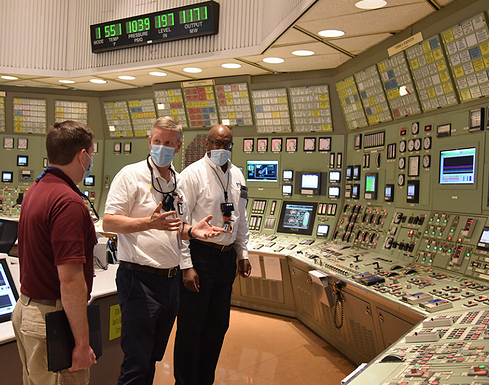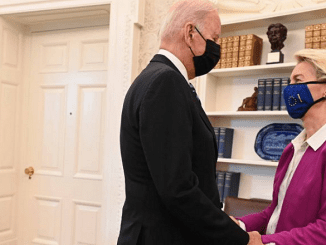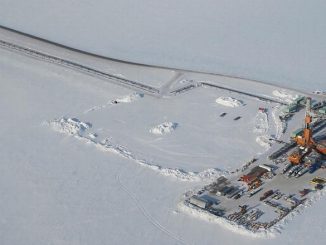
WASHINGTON, DC, January 31, 2022 (ENS) – Two-thirds of U.S. states are considering how to safely install nuclear power to replace the coal, oil, and gas that are being phased out to prevent the worst consequences of climate change, a survey of the energy policies in all 50 states and the District of Columbia has found.
The momentum building behind nuclear power could lead to the first expansion of nuclear reactor construction in the United States in more than three decades, the Associated Press concluded after the results of its survey were in.
Roughly one-third of the states and the District of Columbia responded to the AP’s survey by saying they have no plans to incorporate nuclear power in their green energy goals, instead relying on renewables.
Energy officials in those states said their goals are achievable because of advances in energy storage using batteries, investments in the grid for high-voltage interstate transmission, energy efficiency efforts to reduce demand, and power from hydroelectric dams.
The split over nuclear power in U.S. states is also happening in Europe. Belgium, Germany, Spain and Switzerland plan nuclear phase-outs by 2030.
Other countries, such as France, are staying with the technology or planning to build more nuclear power plants. Nuclear power is the largest source of electricity in France, generating 70.6 percent of the country’s total electricity production, the highest percentage in the world.
The Biden administration, convinced of the climate emergency, is taking a “whole-of-government approach” to slashing greenhouse gases. As a result, the administration views nuclear energy as necessary to make up for the removal of fossil fuels from the U.S. energy grid.
U.S. Energy Secretary Jennifer Granholm says the administration wants to get to zero-carbon electricity, and “that means nuclear, that means hydropower, that means geothermal, that means obviously wind on and offshore, that means solar. We want it all,” Granholm told the AP during a visit in December to Providence, Rhode Island, to promote an offshore wind project.
And the United States is helping at least one EU country to develop its nuclear fleet.
Secretary Granholm and Romanian Minister of Energy Virgil Popescu signed a new commercial partnership between the U.S. company NuScale Power and the Romanian utility Nuclearelectrica on the sidelines of the 26th UN Conference on Climate Change (COP26) in Glasgow, Scotland in November.

The new agreement advances the deployment of Europe’s first small modular reactor, SMR, in Romania by the end of the decade with deployment of a NuScale SMR plant at a retiring coal facility as early as 2027/2028.
“The United States views nuclear energy as a pivotal technology in the global effort to lower emissions, expand economic opportunity, and ultimately combat climate change,” said Secretary Granholm. “We have been supporting the development of SMRs for decades, and it is extremely gratifying to celebrate this important milestone for Romania to help them achieve their climate goals.”
Whatever its drawbacks in terms of disposal of nuclear waste that remains dangerous for thousands of years and the possibility of a deadly explosion, nuclear is a zero-carbon power source.
The planned small modular reactor is intended to help support Romania’s intention to phase out coal-fired energy production by 2032 and supports the U.S.-Romania strategic partnership on civil nuclear energy deployment.
“I welcome this new partnership on SMR technology with NuScale,” said Energy Minster Popescu. “We aim to develop the first SMR this decade in order to meet our critical energy demand and green targets and to secure a quality future for the generations to come. Decarbonization with nuclear possible!”
The Rise of NuScale Power
NuScale Power, with offices in four U.S. states, is already maneuvering to supply Ukraine and Kazakhstan with its small modular nuclear reactors.
The company has been supported by the U.S. Department of Energy, DOE, since 2013, when the Obama administration gave the company a $226 million, five-year, financial assistance award to develop nuclear SMR technology.
In 2015, the DOE awarded NuScale Power $16.6 million to prepare a combined Construction and Operating License Application for NuScale’s first customer, the Utah Associated Municipal Power Systems’ Carbon Free Power Project. UAMPS provides wholesale electricity and transmission, on a nonprofit basis, to community-owned power systems in Utah, California, Idaho, Nevada, New Mexico and Wyoming.
As part of the Carbon Free Power Project, UAMPS will site a NuScale 12-module reference plant in Idaho that is expected to be fully operational by 2027. UAMPS has selected a preferred location at the Idaho National Laboratory through a site-use agreement with the DOE.
In 2018, in a sign of continued support during the Trump administration, the U.S. Department of Energy’s Office of Nuclear Energy awarded NuScale $40 million in cost-sharing financial assistance under its U.S. Industry Opportunities for Advanced Nuclear Technology Development program. This award supports early-stage research and development and the industry’s acceleration of these technologies.
Biden Administration Backs Nuclear
Today, under the Biden administration, support for nuclear development continues. White House National Climate Advisor Gina McCarthy told the “Washington Post,” last May, “There are two ways in which nuclear continues to be an important consideration. Number one is that we do have nuclear facilities that provide significant baseload capacity, and so some of those nuclear facilities are older. We don’t expect them to be carrying the load forever, but we do know that there are many regions in which at least the states themselves feel like the support for those facilities needs to continue while we build an infrastructure of wind and hydro and other mixes moving forward – and solar, of course.”
“There’s a lot of emphasis in investment now in innovation about smaller and more adaptive, if you will, new generation of nuclear,” said McCarthy, who headed the U.S. Environmental Protection Agency under President Barack Obama. “That’s going to be pretty interesting, and people are really investing significant resources to look at these small nuclear reactors, these modular reactors, and whether they come to fruition, I don’t know.”
“They don’t generate the types of waste that traditional nuclear plants generate, and they do offer opportunities for much more smaller applications, with less need for large centralized facilities,” McCarthy explained.

Today, nuclear power provides about 20 percent of all U.S. electricity, about half the country’s carbon-free energy. Most of the 93 reactors now in operation are situated east of the Mississippi River.
In August 2020, the U.S. Nuclear Regulatory Commission approved a small modular reactor design from NuScale Power. Three other companies have told the commission they are preparing applications for their water-cooled designs.
The NRC is expecting about a half dozen designs to be submitted for advanced reactors, which use something other than water to cool the core, such as gas, liquid metal or molten salt, the AP reports.
TerraPower’s Sodium Fast Reactor
A project by Bill Gates’ 10-year-old company, TerraPower, in Wyoming, the nation’s largest coal-producing state, is focused on Natrium technology – an integrated energy system powered by a sodium fast reactor.
TerraPower has selected the coal-fired Naughton power plant near Kemmerer for its proposed 345-megawatt Natrium nuclear power demonstration plant, the first of many that the company and its partners plan to build in Wyoming and across the world.
The Kemmerer location was selected because project partner Rocky Mountain Power plans to retire coal-burning units there before the nuclear power plant target in-service date of 2028, TerraPower President and CEO Chris Levesque said.
Developers expect the Nuclear Regulatory Commission to approve major permits for the Wyoming project within three years, a key to achieving the 2028 in-service date.
TerraPower also partnered with the DOE, which is expected to contribute about $2 billion for the $4 billion project, but only if the 2028 deadline is met, Levesque said.
The TerraPower and GE Hitachi Nuclear Energy Natrium technology features a sodium fast reactor combined with a molten salt energy storage system. A sodium-cooled fast reactor is a fast neutron reactor cooled by liquid sodium.
The Natrium reactor creates heat that can be used to generate electricity immediately or be contained in thermal storage reserves. That heat can be turned into electricity upon demand from the grid when need peaks or renewables are unavailable.

On his blog in 2018, Gates wrote, “Nuclear is ideal for dealing with climate change, because it is the only carbon-free, scalable energy source that’s available 24 hours a day. The problems with today’s reactors, such as the risk of accidents, can be solved through innovation.”
“The United States is uniquely suited to create these advances with its world-class scientists, entrepreneurs, and investment capital. Unfortunately, America is no longer the global leader on nuclear energy that it was 50 years ago. To regain this position, it will need to commit new funding, update regulations, and show investors that it’s serious,” Gates wrote.
TerraPower uses an approach called a traveling wave reactor, TWR, that Gates says “is safe, prevents proliferation, and produces very little waste.”
TWRs differ from other fast-neutron and breeder reactors in their ability to directly use depleted uranium, natural uranium, thorium, spent fuel removed from light water reactors, or some combination of these materials to generate power.
The concept is still in the development stage and no TWRs have ever been built.
But that is about to change. Last December, Southern Company, which serves nine million utility customers in six states, signed an agreement with the DOE to demonstrate world’s first fast-spectrum salt reactor in collaboration with TerraPower and Idaho National Laboratory.
Other states are turning their backs on nuclear in favor of what they consider to be safer power sources.
In New York, with its ambitious goal of limiting climate change, the future energy grid will be dominated by wind, solar and hydropower, said New York State Energy Research and Development Authority President and CEO Doreen Harris.
Harris said she sees a future beyond nuclear, which has fallen from nearly 30 percent of the state’s energy mix to around five percent today after the April 2021 closure of the Indian Point nuclear plant on the Hudson River. She says the state will need advanced, long-duration battery storage and cleaner-burning fuels such as hydrogen.
Across the country, Nevada officials do not consider nuclear power a viable option at all because of an expensive, failed plan to store the nation’s commercial spent nuclear fuel underground at Yucca Mountain. In 2010, the DOE shut down the Yucca Mountain project without citing any technical or safety issues. At the time, $12 billion had already been spent on Yucca Mountain and 65,000 metric tons of spent nuclear fuel were in temporary storage across 39 states.
Instead, Nevada now is focused on geothermal energy and battery technology for energy storage.
“Nevada understands better than most other states that nuclear technology has significant lifecycle problems,” David Bobzien, director of the Nevada Governor’s Office of Energy, said in a statement. “A focus on short-term gains can’t alleviate the long-term issues with nuclear energy.”
Featured image: Nuclear power plant Watts Bar Unit 2, near Spring City, Tennessee went online in 2016, joining six other operating Tennessee Valley Authority nuclear units, meeting the electricity needs of more than 4.5 million homes. (Photo courtesy Tennessee Valley Authority)
© 2022, Environment News Service. All rights reserved. Content may be quoted only with proper attribution and a direct link to the original article. Full reproduction is prohibited.



